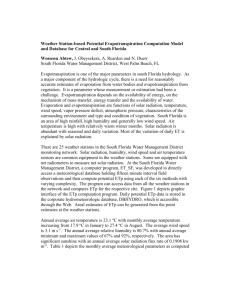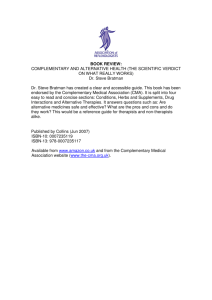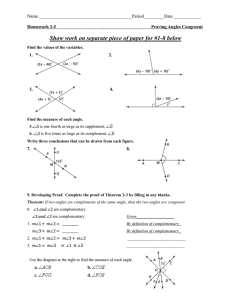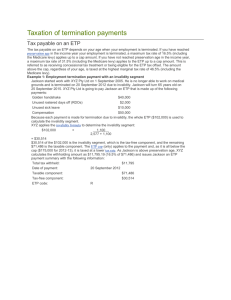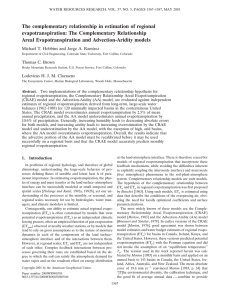Observational evidence of the complementary relationship in regional
advertisement
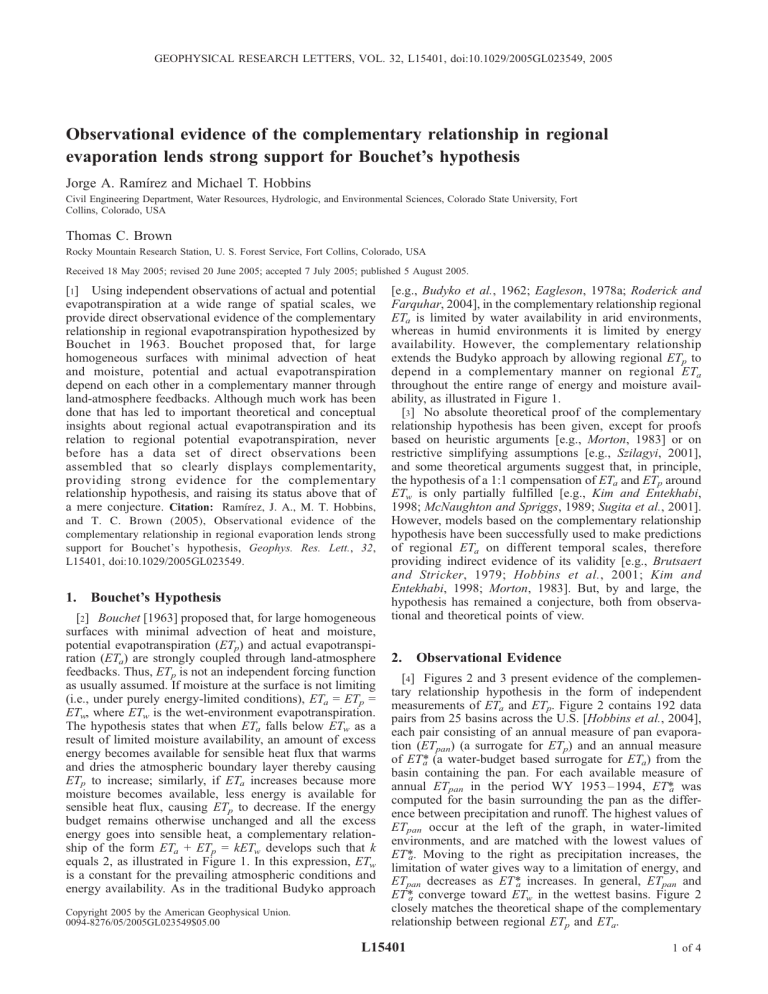
GEOPHYSICAL RESEARCH LETTERS, VOL. 32, L15401, doi:10.1029/2005GL023549, 2005 Observational evidence of the complementary relationship in regional evaporation lends strong support for Bouchet’s hypothesis Jorge A. Ramı́rez and Michael T. Hobbins Civil Engineering Department, Water Resources, Hydrologic, and Environmental Sciences, Colorado State University, Fort Collins, Colorado, USA Thomas C. Brown Rocky Mountain Research Station, U. S. Forest Service, Fort Collins, Colorado, USA Received 18 May 2005; revised 20 June 2005; accepted 7 July 2005; published 5 August 2005. [1] Using independent observations of actual and potential evapotranspiration at a wide range of spatial scales, we provide direct observational evidence of the complementary relationship in regional evapotranspiration hypothesized by Bouchet in 1963. Bouchet proposed that, for large homogeneous surfaces with minimal advection of heat and moisture, potential and actual evapotranspiration depend on each other in a complementary manner through land-atmosphere feedbacks. Although much work has been done that has led to important theoretical and conceptual insights about regional actual evapotranspiration and its relation to regional potential evapotranspiration, never before has a data set of direct observations been assembled that so clearly displays complementarity, providing strong evidence for the complementary relationship hypothesis, and raising its status above that of a mere conjecture. Citation: Ramı́rez, J. A., M. T. Hobbins, and T. C. Brown (2005), Observational evidence of the complementary relationship in regional evaporation lends strong support for Bouchet’s hypothesis, Geophys. Res. Lett., 32, L15401, doi:10.1029/2005GL023549. 1. Bouchet’s Hypothesis [2] Bouchet [1963] proposed that, for large homogeneous surfaces with minimal advection of heat and moisture, potential evapotranspiration (ETp) and actual evapotranspiration (ETa) are strongly coupled through land-atmosphere feedbacks. Thus, ETp is not an independent forcing function as usually assumed. If moisture at the surface is not limiting (i.e., under purely energy-limited conditions), ETa = ETp = ETw, where ETw is the wet-environment evapotranspiration. The hypothesis states that when ETa falls below ETw as a result of limited moisture availability, an amount of excess energy becomes available for sensible heat flux that warms and dries the atmospheric boundary layer thereby causing ETp to increase; similarly, if ETa increases because more moisture becomes available, less energy is available for sensible heat flux, causing ETp to decrease. If the energy budget remains otherwise unchanged and all the excess energy goes into sensible heat, a complementary relationship of the form ETa + ETp = kETw develops such that k equals 2, as illustrated in Figure 1. In this expression, ETw is a constant for the prevailing atmospheric conditions and energy availability. As in the traditional Budyko approach Copyright 2005 by the American Geophysical Union. 0094-8276/05/2005GL023549$05.00 [e.g., Budyko et al., 1962; Eagleson, 1978a; Roderick and Farquhar, 2004], in the complementary relationship regional ETa is limited by water availability in arid environments, whereas in humid environments it is limited by energy availability. However, the complementary relationship extends the Budyko approach by allowing regional ETp to depend in a complementary manner on regional ETa throughout the entire range of energy and moisture availability, as illustrated in Figure 1. [3] No absolute theoretical proof of the complementary relationship hypothesis has been given, except for proofs based on heuristic arguments [e.g., Morton, 1983] or on restrictive simplifying assumptions [e.g., Szilagyi, 2001], and some theoretical arguments suggest that, in principle, the hypothesis of a 1:1 compensation of ETa and ETp around ETw is only partially fulfilled [e.g., Kim and Entekhabi, 1998; McNaughton and Spriggs, 1989; Sugita et al., 2001]. However, models based on the complementary relationship hypothesis have been successfully used to make predictions of regional ETa on different temporal scales, therefore providing indirect evidence of its validity [e.g., Brutsaert and Stricker, 1979; Hobbins et al., 2001; Kim and Entekhabi, 1998; Morton, 1983]. But, by and large, the hypothesis has remained a conjecture, both from observational and theoretical points of view. 2. Observational Evidence [4] Figures 2 and 3 present evidence of the complementary relationship hypothesis in the form of independent measurements of ETa and ETp. Figure 2 contains 192 data pairs from 25 basins across the U.S. [Hobbins et al., 2004], each pair consisting of an annual measure of pan evaporation (ETpan) (a surrogate for ETp) and an annual measure of ET*a (a water-budget based surrogate for ETa) from the basin containing the pan. For each available measure of annual ETpan in the period WY 1953 – 1994, ET*a was computed for the basin surrounding the pan as the difference between precipitation and runoff. The highest values of ETpan occur at the left of the graph, in water-limited environments, and are matched with the lowest values of ET*a. Moving to the right as precipitation increases, the limitation of water gives way to a limitation of energy, and ETpan decreases as ET*a increases. In general, ETpan and ET*a converge toward ETw in the wettest basins. Figure 2 closely matches the theoretical shape of the complementary relationship between regional ETp and ETa. L15401 1 of 4 L15401 RAMÍREZ ET AL.: EVIDENCE OF BOUCHET’S HYPOTHESIS Figure 1. Schematic representation of the complementary relationship in regional evapotranspiration. [5] Bouchet’s complementary relationship implies that k, the ratio of ETa + ETp to ETw, equals 2. Sugita et al. [2001] show that k is a function of both the stomatal resistance, rst, and the aerodynamic resistance, ra, and that k is strictly equal to 2 only for rst = 0 (i.e., for conditions of ample soil moisture) or ra ! 1 (i.e., k approaches 2 as the surface becomes smoother). Using ETpan as a surrogate for ETp, the value of k for the observations shown in Figure 2 has a mean of 2.21 and a variance of 0.07. However, because the complementary relationship is between ETa and ETp, and ETpan is generally related to ETp by a so-called pan coefficient, kp, [Allen et al., 1998], a value of k greater than 2 is not unexpected. Figure 3 includes estimates of ETp obtained as ETp = kpETpan. Computed as the ratio of ETp/ETpan for the 192 estimates of ETpan, where ETp is obtained using Penman equation, the average value of kp equals 0.83 [e.g., Allen et al., 1998]. Using ETp = kpETpan, the value of the ratio of ETa + ETp to ETw for the observations shown in Figure 3 has a mean of 1.97 and a variance of 0.05. Such agreement of theory and observation is striking, especially for a data set L15401 covering such a large geographical area and long temporal span. Furthermore, noting that the observations in Figures 2 and 3 have fundamentally different scales (ETp and ETw are point observations at pans or meteorological stations, whereas ET*a is an areal observation) this agreement is all the more remarkable, and raises the possibility that improved data could reveal even more precisely the complementarity of ETa and ETp. If better data were available, exceptions to the complementarity might be revealed, but at this point it must be concluded that the complementary relationship hypothesis has substantial empirical support. [6] Figures 2 and 3 correspond to a composite of 192 pans in 25 different basins over the continental U.S., spanning the full climatic range from arid to humid. Lumping basins from widely different environments into one graph allows one to depict the full range of humidity but takes us beyond the strict interpretation of Bouchet’s hypothesis. A more rigorous description of the behaviour of the evaporation fluxes for a fixed region is presented in Figures 4– 6, showing the complementary relationship behaviour for three individual basins. Using the climate classification of Eagleson [1978b], the basin shown in Figure 4 (Peace River at Arcadia, central Florida) corresponds to a climate spanning a range from semi-arid to semi-humid, that is, a climate with a potential humidity ratio between 0.7 and 1.2; the basin shown in Figure 5 (Salt River near Roosevelt, eastern Arizona) corresponds to a climate spanning the range between arid and semi arid; and the basin shown in Figure 6 (Guadalupe River near Spring Branch, central Texas) corresponds to a semi-arid climate. Although the data plotted in Figures 4– 6 correspond to different years, each plot can be considered as showing the expected instantaneous response of ETp and ETa to changes in moisture availability. This is so because the magnitude of ETw is relatively constant. Clearly, Figures 4 – 6 show that the complementary relationship is also observable for each individual basin (i.e., for a fixed region). 3. Concluding Remarks [7] To summarize, using independent observations of actual and potential evapotranspiration combined with an Figure 2. Point annual depths of ETpan and basinwide annual depths of ET*a. Data for a single basin-pan pair line up vertically. ET*a is calculated for each basin as the difference between precipitation and runoff, the former data obtained from the PRISM data set and the latter extracted for USGS gages listed in the Hydroclimatic Data Network of relatively undisturbed basins. ETw is computed using the Priestley and Taylor equation. The potential humidity index F is defined as the ratio of annual precipitation to wet environment evapotranspiration. Figure 3. Point annual depths of ETp and basinwide annual depths of ET*a. ETp is calculated as kpETpan, where kp is the pan coefficient. Data for a single basin-pan pair line up vertically. ET*a, ETw, and F are as in Figure 2. 2 of 4 L15401 RAMÍREZ ET AL.: EVIDENCE OF BOUCHET’S HYPOTHESIS Figure 4. Pan ID 84707 – Basin ID 02296750ID: Peace River at Arcadia, Florida, in HUC 03100101 (WRR 3: South Atlantic-Gulf) [data source: Slack and Landwehr, 1992]. adjustment for the pan coefficient, we have offered the first large-scale direct observational evidence of the complementary relationship in regional evapotranspiration, and have shown that the relationship is evident at individual basins. Although much work has been done that has led to important theoretical and conceptual insights about regional ETa and its relationship with ETp [e.g., Brutsaert and Parlange, 1998; Brutsaert and Stricker, 1979; Hobbins et al., 2001; Kim and Entekhabi, 1998; Morton, 1983; Ozdogan and Salvucci, 2004; Sugita et al., 2001; Szilagyi, 2001], never before has a data set of direct observations been assembled that so clearly displays complementarity. [8] The complementary relationship has important applications in the field of water management [e.g., Hobbins et al., 2001; Ozdogan and Salvucci, 2004] and in explaining observed trends in climate variables associated with climate change. For example, the complementary relationship was recently invoked in the context of the so-called pan evaporation paradox [Brutsaert and Parlange, 1998; Ohmura and Wild, 2002; Roderick and Farquhar, 2002; Hobbins et al., 2004]. The pan paradox refers to the seemingly paradoxical observation of a decreasing trend in ETpan over the past half-century concurrent with an increase of global Figure 5. Pan ID 27281– Basin ID 09498500: Salt River near Roosevelt, Arizona, in HUC 15060103 (WRR 15: Lower Colorado) [data source: Slack and Landwehr, 1992]. L15401 Figure 6. Pan ID 411429 – Basin ID 08167500: Guadalupe River near Spring Branch, Texas, in HUC 12100201 (WRR 12: Texas-Gulf) [data source: Slack and Landwehr, 1992]. average surface temperatures. Our result supports arguments explaining the pan paradox as simply a manifestation of the complementarity between ETa and ETp [Brutsaert and Parlange, 1998; Hobbins et al., 2004]. [9] Acknowledgment. The U.S. Forest Service and the U.S. National Science Foundation supported this work. References Allen, R. G., L. S. Pereira, D. Raes, and M. Smith (1998), Crop evapotranspiration guidelines for computing crop water requirements, Food Agric. Org. U. N. FAO Irrig. Drain. Pap. 56, Rome, Italy. Bouchet, R. J. (1963), Evapotranspiration réelle evapotranspiration potentielle, signification climatique, pp. 134 – 142, in International Association of Scientific Hydrology, General Assembly of Berkeley, Transactions, vol. 2, Evaporation, Berkeley, Calif. Brutsaert, W., and M. Parlange (1998), Hydrologic cycle explains the evaporation paradox, Nature, 396, 30. Brutsaert, W., and H. Stricker (1979), An advection-aridity approach to estimate actual regional evapotranspiration, Water Resour. Res., 15(2), 443 – 450. Budyko, M. I., N. A. Efimova, L. I. Zubenok, and L. A. Strokina (1962), The heat balance of the Earth’s surface, Izv. Akad. Nauk SSSR, Ser. Geogr., 1, 6 – 16. Eagleson, P. S. (1978a), Climate, soil, and vegetation, part 4: The expected value of annual evapotranspiration, Water Resour. Res., 14(5), 731 – 739. Eagleson, P. S. (1978b), Climate, soil, and vegetation, part 7: A derived distribution of annual water yield, Water Resour. Res., 14(5), 765 – 776. Hobbins, M. T., J. A. Ramı́rez, and T. C. Brown (2001), The complementary relationship in estimation of regional evapotranspiration: An enhanced advection-aridity model, Water Resour. Res., 37(5), 1389 – 1403. Hobbins, M. T., J. A. Ramı́rez, and T. C. Brown (2004), Trends in pan evaporation and actual evaporation across the conterminous U.S.: Paradoxical or complementary?, Geophys. Res. Lett., 31, L13503, doi:10.1029/2004GL019846. Kim, C. P., and D. Entekhabi (1998), Feedbacks in the land-surface and mixed-layer energy budgets, Boundary Layer Meteorol., 88(1), 1 – 21. McNaughton, K. G., and T. W. Spriggs (1989), An evaluation of the Priestley-Taylor equation and the complementary relation using results from a mixed layer model of the convective boundary layer, in Estimation of Areal Evapotranspiration, edited by T. A. Black et al., pp. 89 – 103, IAHS Press, Wallingford, U. K. Morton, F. I. (1983), Operational estimates of areal evapotranspiration and their significance to the science and practice of hydrology, J. Hydrol., 66, 1 – 76. Ohmura, A., and M. Wild (2002), Is the hydrologic cycle accelerating?, Science, 298, 1345 – 1346. Ozdogan, M., and G. D. Salvucci (2004), Irrigation-induced changes in potential evapotranspiration in southeastern Turkey: Test and application of Bouchet’s complementary hypothesis, Water Resour. Res., 40, W04301, doi:10.1029/2003WR002822. 3 of 4 L15401 RAMÍREZ ET AL.: EVIDENCE OF BOUCHET’S HYPOTHESIS Roderick, M. L., and G. D. Farquhar (2002), The cause of decreased pan evaporation over the past 50 years, Science, 298, 1410 – 1411. Roderick, M. L., and G. D. Farquhar (2004), Changes in Australian pan evaporation from 1970 to 2002, Int. J. Climatol., 24, 1077 – 1090. Slack, J. R., and J. M. Landwehr (1992), Hydro-climatic data network (HCDN): A U.S. Geological Survey streamflow data set for the United States for the study of climate variations, 1874 – 1988, U.S. Geol. Surv. Open File Rep., 92 – 129, 193. Sugita, M., J. Usui, I. Tamagawa, and I. Kaihotsu (2001), Complementary relationship with a convective boundary layer model to estimate regional evaporation, Water Resour. Res., 37(2), 353 – 365. L15401 Szilagyi, J. (2001), On Bouchet’s complementary hypothesis, J. Hydrol., 246(1 – 4), 155 – 158. T. C. Brown, Rocky Mountain Research Station, U. S. Forest Service, Fort Collins, CO 80526, USA. M. T. Hobbins and J. A. Ramı́rez, Civil Engineering Department, Water Resources, Hydrologic and Environmental Sciences, Colorado State University, Fort Collins, CO 80523 – 1372, USA. (jorge.ramirez@colostate. edu) 4 of 4

